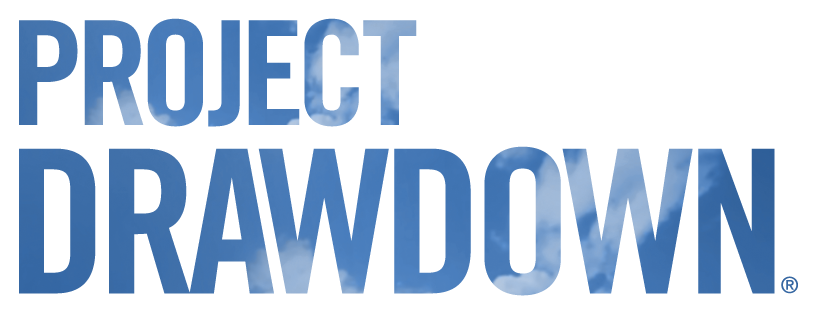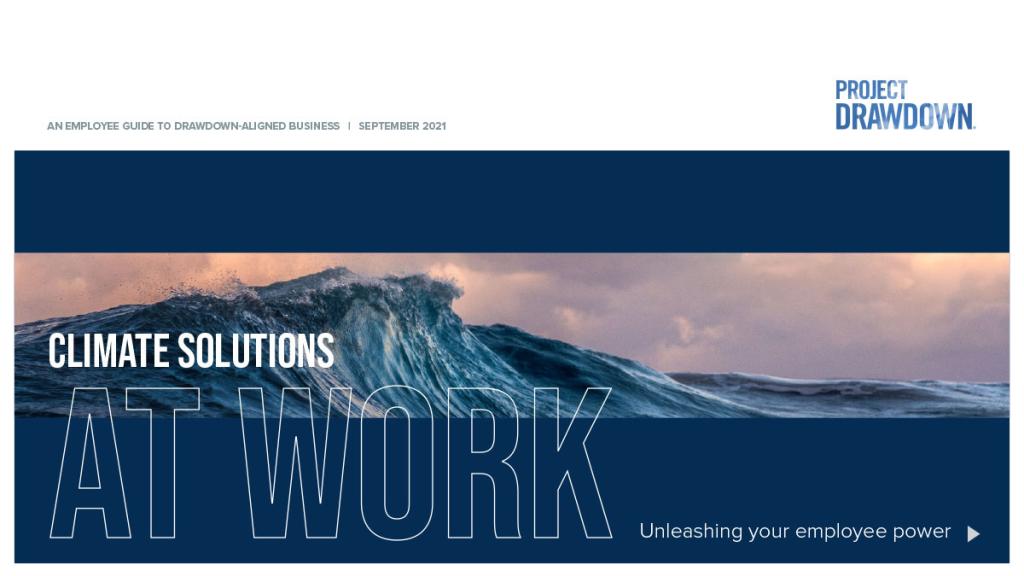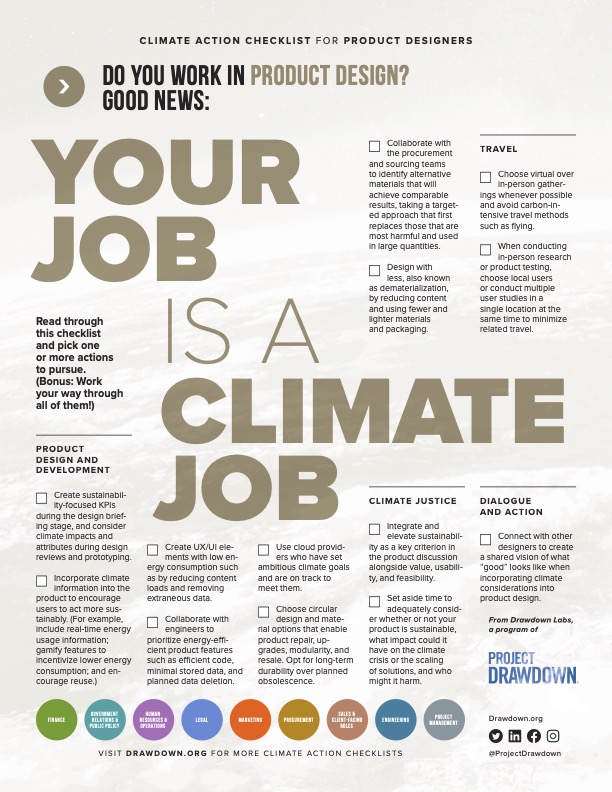Climate Solutions at Work
Product designers bring a range of skills and work across departments to make critical decisions about how users will interact with a product or feature. This puts you in a good position to advocate for meaningful climate considerations within your company. Climate solutions can be incorporated into the design process in a variety of ways, from sustainable prototyping and low-carbon materials to incorporating actionable climate information so that consumers or users are empowered to adopt more sustainable behaviors.
Please keep in mind that the scope of your role, your company, and the industry in which it operates may make some actions more or less applicable. We recognize that product design may overlap with other product development roles; for more ideas, see the Product Management and Engineering action guides. We encourage you to explore the actions in all of the guides to see which are most relevant to you!
Lastly, have you used this or any of our Job Function Action Guides to make your job a climate job? If so, we want to hear about it! We encourage you to share your story with us by emailing labs@drawdown.org
To make your product design job a climate job:
Integrate climate into design and development
All products
- Create sustainability-focused KPIs, such as energy consumption, water usage, and waste creation, during the design brief stage to ensure climate is a key component of product success – and keep climate impacts and attributes in mind during design reviews and prototyping.
- Incorporate well-placed and well-timed climate information into the product to encourage users to behave more sustainably. For example: include real time information on energy usage of the product; gamify features to incentivize lower energy consumption; encourage reuse; and incorporate carbon labeling.
- Integrate behavioral science into product design. Understanding key points along the user journey allows you to use decision-making psychology to guide your users toward more sustainable actions. (Check out this article on “climate behavioral interventions.”)
- Include product features that make climate information and education more accessible – how can your product assist users in becoming more aware of and resilient to extreme weather events or in finding climate information relevant to their community? (See this example from Google.)
- Emphasize when the sustainable option aligns with other factors that users care about, such as cost and health.
- Collaborate with writers, editors, and marketers to ensure that the copy in your product prompts the user to take action.
Digital products
- Design UX/UI elements for minimized energy consumption. Microsoft's Green Design Principles include ideas like:
- Reduce content loads and avoid auto-loading content (make energy-intensive features optional).
- Minimize and simplify visuals and media.
- Remove unnecessary data.
- Collaborate with engineers to prioritize energy efficiency by doing things like writing efficient code, minimizing stored data, and planning for data deletion.
- Use cloud providers who have set – or are on track to meet – their own ambitious climate goals. (See this four-part series on greenhouse gas emissions from cloud providers.)
Physical products
- Collaborate with internal and external partners, as well as experts in circular economy and sustainable materials, to evaluate all material and design options.
- Assess the potential benefits and consequences of different materials for your product – beyond just greenhouse gas emissions – to consider other potentially harmful effects on people and the planet, such as water use, biodiversity impacts, and chemical pollution.
- Consult experts on topics such as packaging and manufacturing to ensure that potential downstream effects are taken into account early in the design process.
- Design with less – also known as dematerialization – by reducing content and using fewer and lighter materials and packaging.
- Choose circular design and material options that enable product repair (like Patagonia), upgrades and adaptations, modularity (like Fairphone), reuse, and resale. Avoid planned obsolescence and prioritize durability.
- If designing for take-back and recycling, keep in mind the complexities and ambiguity surrounding recycling. For more information, see this guidance.
- Consider made-to-order sales models. (Check out this example.)
- Collaborate with the procurement and sourcing teams to identify sufficient alternative materials. Take a targeted approach, first replacing the most harmful materials or ingredients that you use in large quantities. Use verification tests to show comparable performance.
- Bring in experts and use other resources to educate your team on sourcing "rules of thumb." For example, across various raw materials, there are global deforestation hotspots that your company should generally avoid to reduce its contribution to ecosystem destruction. (Consult resources like Climate TRACE’s emissions data comparison tool and Project Drawdown’s Drawdown Roadmap.)
Many of the above actions will likely be dependent on your company's overall business model – try to find more information on your company's operational capabilities that are required to support circular design choices.
Embed climate justice
- Integrate and elevate sustainability and equity as key criteria in the product discussion alongside value, usability, and feasibility. Is this product sustainable? Is it contributing to climate change or helping accelerate solutions? Who might this product harm? Set aside the time and space to adequately consider these questions.
- The climate crisis does not affect everyone equally. Work to go beyond your product's immediate response and short-term benefits and focus on the potential long-term benefits and impacts, particularly for those communities most vulnerable to climate change. (To evaluate the potential harms that your product might create, check out Spotify’s Ethics Assessment template.)
Educate yourself and your colleagues
- Create upskilling opportunities around climate-friendly and circular design in collaboration with your company's human resources team, sustainability team, and/or sustainability employee resource group.
- Encourage your team to develop internal tools for designers to use when incorporating sustainability into their work.
- Leverage industry groups focused on sustainability and climate action, such as Climate Designers.
Reassess team travel
- Reduce carbon-intensive business travel for you and your team by opting for virtual meetings. If you can, avoid flying and instead take a train or use another mode of transportation that emits fewer emissions.
- When conducting in-person research, opt for local users. If that’s not possible, conduct multiple user studies in a single geographic location at one time.
Foster dialogue and action
- Build capacity and knowledge by connecting with other designers – and other colleagues in your organization. Come together to brainstorm climate action steps (check out Project Drawdown's Discover page for ideas!), share best practices, and raise your collective concern at team and all-staff meetings.
Ready to take action? Here are some questions and ideas to help you get started:
Take stock
Identify your company’s corporate sustainability and climate commitments, if any.
- Are these goals related to the objectives of the product design team?
- Can you incorporate the actions listed above into your company, team, or individual performance goals?
- Does your company have a goal to reduce Scope 3 emissions (emissions from the use of its products)?
- Does the product team specify sustainable materials, follow low-carbon and circular principles, and/or use other criteria when developing products?
- Is there a mandate or incentive in place for leadership to incorporate sustainability value commitments into all new product development?
- Can you start or join a green team or a climate employee resource group?
Make needed changes or reach out to someone else who can.
- What kind of decision-making authority do you have? Can you carry out these actions on your own, or do you need to consult with a manager or director?
- Are those with decision-making authority already on board with climate action? Is there anyone you might be able to engage and influence?
Test the waters by discussing your personal interest in climate action with trusted colleagues and gauging their reactions. Consult power-mapping tools for help.
You don’t have to do it alone
Find others in your department who are climate-concerned. Join forces to demonstrate widespread support for incorporating climate action into product design and across the organization. Consider writing a letter or petition to management or bringing up your concerns at an all-staff meeting.
Need help making the business case?
According to research from CDP, Scope 3 emissions on average account for roughly three-quarters of a company's total emissions. These are indirect emissions that result from customers using the products or services a company offers. And because over 80% of emissions from product use can be traced back to the design phase, designers have a significant opportunity to mitigate emissions and help companies meet their net-zero targets. While increased costs are frequently cited as a barrier to incorporating climate considerations into product design, surveys have shown that costs do not always rise. Moreover, even when increased costs are incurred, the resulting benefits – such as increased employee engagement and customer satisfaction – can often outweigh them. In fact, the majority of young people prefer to buy sustainable over brand-name products, implying that the case for sustainable product design will only strengthen as this segment's purchasing power grows. As climate change disrupts supply chains, it will become increasingly important for product designers to use not only more sustainable but also fewer materials in order to create great products that are resilient to the effects of the climate crisis.
Resources
Software
Circularity and materials
Behavioral science
Communicating and marketing sustainability
- The Sustainable Fashion Communication Playbook provides “principles and guidance on how to align consumer-facing communication across the global fashion industry with sustainability targets.” The playbook is geared toward the fashion industry but includes information relevant to all products and industries.
- This blog post by Google provides helpful tips on what to avoid when communicating about sustainability.
Climate justice
Overall design
Everyone has a role to play
The Drawdown Labs Job Function Action Guides will help employees understand how their roles are critical in addressing the climate crisis, as well as implement high-impact solutions and navigate key considerations for taking action inside the workplace.
Partnerships
and Community
Affairs
Please note: This graphic is illustrative of how different teams across a company must work together to achieve strong climate action. We encourage you to examine your organization’s own unique structure to determine how to best coordinate and integrate climate action across functions.


